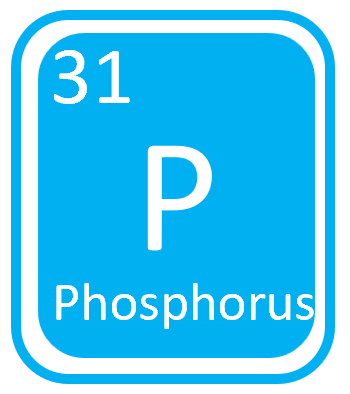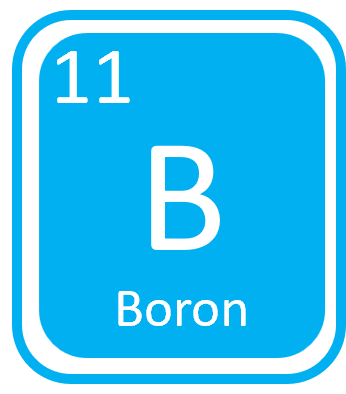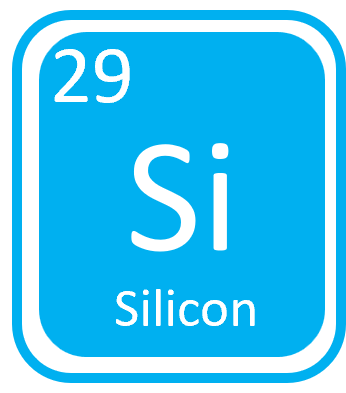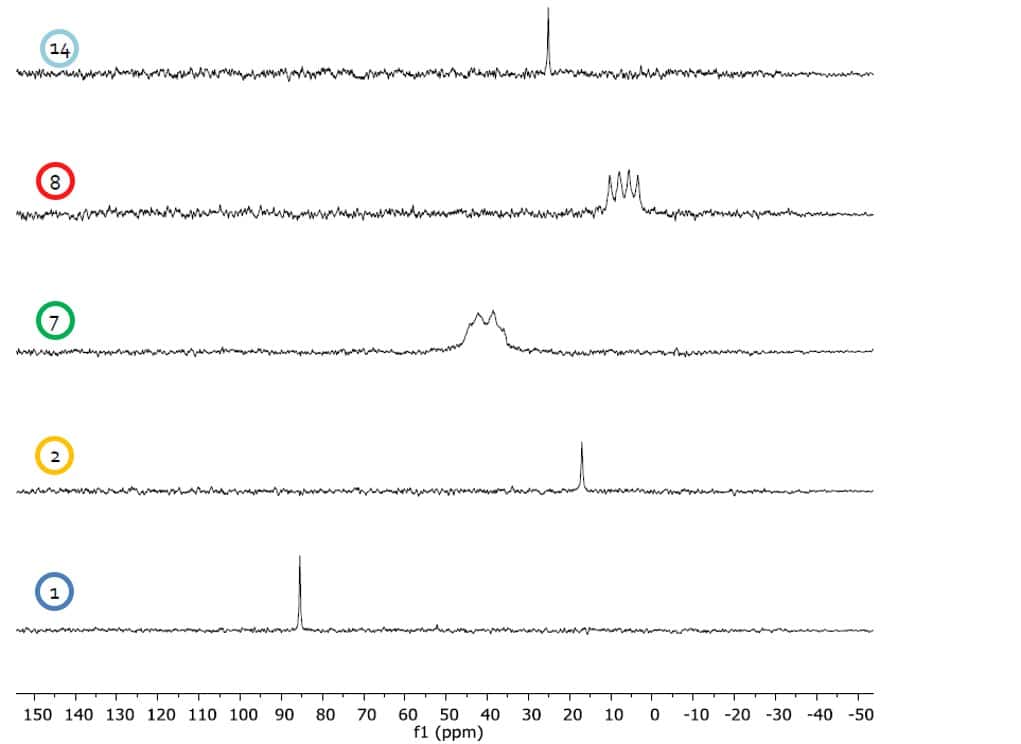
Home Products Spinsolve family Spinsolve addons Multinuclear Options
The new Spinsolve Multi Xn redefines automated multinuclear NMR by allowing users to configure and measure as many X nuclei as needed — even 15 or more — without compromising performance. All selected nuclei are factory pre-calibrated across the full library of available protocols, ensuring seamless, high-quality data acquisition with zero set up time. The Spinsolve Multi Xn automatically switches between different nuclei over a broad frequency band, enabling unattended execution of complex multinuclear experiments. Combined with the Spinsolve sample changer and enhanced queueing functionality, users can now run high-throughput, fully automated workflows across a wide range of samples and nuclei with unprecedented flexibility and efficiency.
Unlimited Nuclei, Highest Sensitivity, No Compromise
All Spinsolve Multi Xn systems are built on a dual-channel architecture, which ensures that adding more nuclei has no impact on sensitivity, lineshape, or overall performance. This advanced design not only maintains optimal detection conditions across a high number of nuclei, but also enables powerful decoupling capabilities. Users can easily perform proton decoupling from X nuclei, decouple X nuclei from protons, and even apply simultaneous decoupling from both proton and fluorine. Whether you’re running simple experiments or complex multinuclear protocols, Spinsolve Multi X delivers high-quality results with exceptional flexibility.
Choose the Nuclei You Need
Configure your Spinsolve Multi Xn to match your exact experimental needs. Choose any number of X nuclei from the selection below, or go beyond — we’ll calibrate even non-listed nuclei upon request.
Advanced Decoupling Capabilities
The Spinsolve Multi Xn system offers powerful decoupling capabilities that provide clear advantages in multinuclear NMR experiments. With its advanced dual-channel architecture, it supports decoupling of all X nuclei from protons, as well as decoupling of protons from X nuclei, depending on the specific requirements of the user and the experiment. This flexibility allows users to simplify complex coupling patterns and obtain more interpretable spectra. In addition, the system enables simultaneous decoupling from both proton and fluorine, opening up advanced multinuclear experiments that are rarely achievable on benchtop instruments. All decoupling options are fully supported across the pre-calibrated protocol library, ensuring reliable performance without the need for manual adjustments — while still leaving full control in the hands of the user.
Application Examples - The Power of Multi Xn
The Spinsolve Multi Xn opens new possibilities in benchtop NMR by enabling flexible, high-sensitivity detection across a broad range of nuclei. The following examples illustrate how combining different nuclei in a single system provides deeper insight into molecular structure, reactivity, and dynamics — all achieved with ease on a compact, automated platform.
Example 1: Comprehensive ¹³C and ³¹P NMR Characterization of a SPhos Ligand
This example showcases the power of combining ¹³C and ³¹P NMR to fully characterize the SPhos ligand, a key component in palladium-catalyzed cross-coupling reactions. Using a suite of experiments — including 1D, HSQC-ME, and HMBC for ¹³C, as well as 1D and HMBC for ³¹P — it is possible to confidently assign both the carbon backbone and the phosphorus environment of the molecule.
The ¹³C HSQC-ME spectrum provides direct one-bond correlations between protons and carbons, while the HMBC reveals longer-range couplings that support the connectivity across the ligand framework. In parallel, the ³¹P HMBC spectrum allows correlation of the phosphorus atom with nearby protons, giving critical insight into the ligand’s geometry and substituent effects.
Together, this combination of experiments demonstrates how the Spinsolve Multi XN enables fast, high-quality multinuclear analysis on a benchtop system — offering advanced structural tools for ligand development, catalyst screening, and routine verification.

Example 2: Multinuclear HMBC for Nitrogen Assignment in Epoxiconazole
In this example, ¹³C–¹H and ¹⁵N–¹H HMBC spectra were acquired to fully assign the carbon and nitrogen atoms in the fungicide Epoxiconazole, which contains a 1,2,4-triazole ring. While ¹³C–¹H HMBC supports comprehensive carbon assignment, the ¹⁵N–¹H HMBC is essential for identifying the distinct nitrogen environments in the ring. Despite the low natural abundance of ¹⁵N, the Spinsolve Multi Xn achieves excellent signal-to–noise from small sample volumes, demonstrating its capability for detailed structural analysis using complementary nuclei.
Example 3: Monitoring Boron Species in a CBS Reaction
This final example highlights the use of ¹³C and ¹¹B 1D NMR spectra to monitor a Corey–Bakshi–Shibata (CBS) reduction reaction. By acquiring ¹¹B spectra at different stages, users can observe the transformation of boron-containing species throughout the catalytic cycle. The ¹³C spectrum complements this by confirming the formation of key intermediates and products. This multinuclear approach provides direct, real-time insight into the behavior of boron-based catalysts — a powerful tool for reaction monitoring and mechanistic studies.

The stacked spectra show the zoom of the aromatic region of the 13C spectra of a) the starting material acetophenone and b) the boron intermediate after the reaction. A clear difference between the spectra can be observed. The carbonyl peak 7 of acetophenone is absent in the spectrum of the intermediate product. In addition, the signal for carbon 6 shifts towards a lower chemical shift value of 127 ppm
- a) CBS-Me pre-catalyst showing a broad signal (orange)
- b) spectrum of the 1M BH3*THF solution with borane signal (blue)
- c) mixture of the free BH3*THF (blue), the –N-BH3 signal of the activated CBS-catalyst (yellow) and a broad signal range with a corresponding signal at around -15 ppm and a broad signal range at around 20-40 ppm (red) containing different signals of monomeric/dimeric B-Me signals
X = 13 Carbon
13C is the most common X-nuclei as it can often be used to confirm or elucidate the structure of organic molecules. The Spinsolve Carbon comes with a large library of advanced 1D and 2D sequences all implemented in a way, that they are easy to run. Besides modern 2D sequences like HSQC-ME and HMBC that make full use of the information content and sensitivity gain of 1H detected heteronuclear methods, the Spinsolve Carbon instruments can as well acquire triple-nuclei experiments like 13C detected experiments with simultaneous 1H-, 19F-decoupling. The graph on the left shows a multiplicity edited – HSQC spectrum of quinine in which all resonances can be unambiguously assigned. The graph on the right shows 13C spectra of 5-bromo-1,2,3-trifoluorobenzene without decoupling, with 1H-decoupling, and with combined 1H-, 19F-decoupling.

X = 31Phosphorus
Phosphorus is commonly found in many organic compounds, for example in biological membranes or DNA. The 31P nucleus has a 100% natural isotopic abundance and a large chemical shift range, making it one of the most commonly used nuclei in biological NMR. It is as well used in organic synthesis for example in the characterization of phosphor ligands for homogenous catalysis.

Download resources:
- Brochure Spinsolve Phosphorus
- Blog Post Spinsolve 80 Phosphorus – Limit of Detection
- Publication Quantification of Ammonium Phosphatide Emulsifiers in Chocolate Using 31P NMR Spectroscopy
- Publication 1H and 31P benchtop NMR of liquids and solids used in and/or produced during the manufacture of methamphetamine by the HI reduction of pseudoephedrine/ephedrine
Phosphorus is commonly found in many organic compounds, for example in biological membranes or DNA. The 31P nucleus has a 100% natural isotopic abundance and a large chemical shift range, making it one of the most commonly used nuclei in biological NMR. It is as well used in organic synthesis for example in the characterization of phosphor ligands for homogenous catalysis.
Graph 2 shows 31P spectra taken at different steps of a phosphine ligand synthesis. The Spinsolve can be easily used to follow reactions as it is compatible with J. Young tubes that are often used for such type of air sensitive compounds.
Graph 1 shows a spectrum of a Nucleoside phosphoramidite, where in full scale only the product peak is visible, however, by magnifying the baseline impurities with a total content of less than 1 % are revealed.
Protocols available additional to the single-channel system:
- 1D Phosphorus with and without 1H decoupling
- 1H-31P- HMBC
X = 11Boron
There are two naturally occurring NMR active nuclei of Boron, 11B (80.1%) and 10B (19.9%). Both nuclei are quadrupolar with spin of greater than ½. 11B has a spin of 3/2 and 10B is spin 3. In terms of sensitivity, 11B is the better nucleus to use as it has a higher natural abundance, a higher gyromagnetic ratio, and a lower quadrupole moment. A Spinsolve benchtop NMR spectrometer with a proton frequency of 60 MHz can be configured to measure the 11B NMR signal which has a frequency of 19.2 MHz.

Download resources:
The 11B NMR spectrum of a 0.23 M solution of sodium tetraphenylborate in MeOH-d4 is shown below. The spectrum shows the excellent sensitivity of the Spinsolve system using just 8 scans to acquire a spectrum in only 16 seconds.
X = 29Silicon
Silicon is one of the most widespread elements in the natural world and, as such, makes it a very interesting and useful element to study using NMR.
Of the isotopes of silicon, only 29Si is NMR active. It has a natural abundance of 4.7% and the gyromagnetic ratio is 8.465 MHz/T, giving 29Si an NMR frequency of around 12.3 MHz on a Spinsolve 60 system and a receptivity (sensitivity) a little over double that of 13C. In addition, 29Si is a spin-1/2 nucleus, so its lines are sharp since there is no quadrupole moment.

Download resources:
Graph 1 shows a 29Si{1H} spectrum of 1,1,3,3,5,5-hexamethyltrisiloxane with inverse gated decoupling.
To overcome the need of extensively long repetition times due to the long T1 times of 29Si, the Spinsolve can as well run 29Si –1H DEPT experiments which can shorten measurement times tremendously. Additionally, graph 3 shows that more advanced techniques like 2D 1H-29Si HMBC can be applied as well to get deeper insight into the moleculcar structure.











